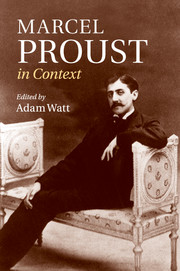Book contents
- Frontmatter
- Contents
- List of Illustrations
- Notes on contributors
- Figure I. Marcel Proust, portrait in oils by Jacques-Émile Blanche, 1892
- Preface
- Figure 2. Proust photographed on his death-bed by Man Ray, 1922
- Note on the text
- Chronology
- Part I Life and works
- Part II Historical and cultural contexts
- Part III Critical reception
- Chapter 24 Critical reception during Proust's lifetime
- Chapter 25 Early critical responses, 1922 to 1950s
- Chapter 26 Mid-twentieth-century views, 1960s to 1980s
- Chapter 27 Late-twentieth- and twenty-first-century responses
- Chapter 28 Modernism
- Chapter 29 Adaptations/afterlives
- Chapter 30 Translations
- Further reading
- Index
- References
Chapter 30 - Translations
from Part III - Critical reception
Published online by Cambridge University Press: 05 November 2013
- Frontmatter
- Contents
- List of Illustrations
- Notes on contributors
- Figure I. Marcel Proust, portrait in oils by Jacques-Émile Blanche, 1892
- Preface
- Figure 2. Proust photographed on his death-bed by Man Ray, 1922
- Note on the text
- Chronology
- Part I Life and works
- Part II Historical and cultural contexts
- Part III Critical reception
- Chapter 24 Critical reception during Proust's lifetime
- Chapter 25 Early critical responses, 1922 to 1950s
- Chapter 26 Mid-twentieth-century views, 1960s to 1980s
- Chapter 27 Late-twentieth- and twenty-first-century responses
- Chapter 28 Modernism
- Chapter 29 Adaptations/afterlives
- Chapter 30 Translations
- Further reading
- Index
- References
Summary
In 1929 E. M. Forster expressed a faint reservation about C. K. Scott Moncrieff's ‘monumental translation’ of the first five volumes of À la recherche du temps perdu in these terms: ‘I was hoping to find Proust easier in English than in French, and do not. All the difficulties of the original are here faithfully reproduced.’ In 1981, the year of the publication of his own revision of Scott Moncrieff's work, Terence Kilmartin cited the ‘story that discerning Frenchmen preferred to read Marcel Proust in English on the grounds that the prose of À la recherche du temps perdu was deeply un-French and heavily influenced by writers such as Ruskin’.
The mythical expectations meet up across more than fifty years. Forster was hoping for, or pretending to hope for, precisely what the discerning Frenchmen claimed to find, and the parties on both sides were not only espousing a theory of translation as clarification but unintentionally shoring up Proust's own claim that ‘each artist seems . . . to be a native of an unknown country’ (5: 290; iii, 761). In Proust's view and practice, the artist encounters the reader on this ground, where both may be strangers to themselves (‘l'ouvrage de l'écrivain n'est qu'une espèce d'instrument optique qu'il offre au lecteur afin de lui permettre de discerner ce que sans ce livre il n'eût peut-être pas vu en soi-même’, iv, 489–90); the myths replace the unknown country with a wish for a known one, certainly foreign but at least in touch with a national spirit in a way the actual text is not.
- Type
- Chapter
- Information
- Marcel Proust in Context , pp. 230 - 240Publisher: Cambridge University PressPrint publication year: 2013
References
- 1
- Cited by

